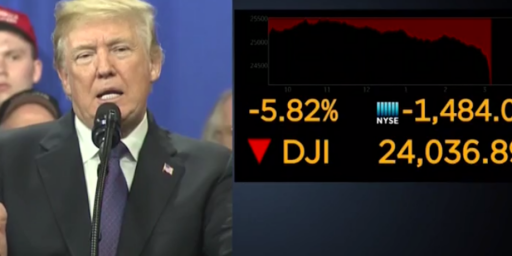Decline in Unauthorized Immigrants May be Reversing
Via Pew Research: Population Decline of Unauthorized Immigrants Stalls, May Have Reversed
The sharp decline in the U.S. population of unauthorized immigrants that accompanied the 2007-2009 recession has bottomed out, and the number may be rising again. As of March 2012, 11.7 million unauthorized immigrants were living in the United States, according to a new preliminary Pew Research Center estimate based on U.S. government data.
The estimated number of unauthorized immigrants peaked at 12.2 million in 2007 and fell to 11.3 million in 2009, breaking a rising trend that had held for decades. Although there are indications the number of unauthorized immigrants may be rising, the 2012 population estimate is the midpoint of a wide range of possible values and in a statistical sense is no different from the 2009 estimate.
A chart and more at the link.
At first blush this would seem to indicate that as the US economy recovers, more people are coming here seeking jobs. If true, this underscores the rather obvious market-driven nature of the immigration conundrum and further shows how dense many in Congress are being in their inability to address the problem as such. It is especially frustrating that the political party that is supposedly all about the role of markets fails to see the simple supply/demand factors at work here.
Of course, almost the entire immigration debate is mired in an ability to directly address reality.






Is there any possibility that “we” might be doing a better job at counting the number of unauthorized?
Just saying…
But wait, we all know that Obama destroyed the economy, and there is little left of America but a scorched wasteland…
The article also mentions that an increasing share of them are non-Mexican immigrants, which would be a change.
Up here in the PNW the emphasis on Mexican illegals has been confusing/weird. In the agricultural areas a significant portion of the illegals speak Spanish as a second language (and no English). They are indigenous folks from far southern Mexico (Chiapas) and Central America (Guatemala, Honduras, El Salvador…) – major cottage industry is translating Mayan (or similar Central American languages) to English in the court systems (usually via Spanish, company in Mexico City does it via teleconference). These are the poorest of the poor, indigenous (Indians). As for the legal immigrants, most of them have Mexican ancestry and the Yakima Valley is ~ 50% Hispanic (or more, like Sunnyside and Grandview WA) – and most are US Citizens or green card holders.
In the urban areas, we have lots of illegal Asians – mostly SE Asia (to include SE China) plus Korea. Plus the taxi cab business has been taken over by East African immigrants (not all legal) – Somalia & Kenya. Major racial tensions over immigrant blacks taking jobs from African-Americans.
I support a return of the agricultural Bracero Program.
Which came first, the chicken or the egg?
If demand for labor rises, one would expect more illegal immigration unless more is done to prevent it (not that we do nothing now – the “open borders” claim is untrue).
We could crack down on employers. Few in power wish to do this. The GOP doesn’t want to because the glorious job creators are its funders and it wouldn’t do to treat them like criminals. The Dems because they’re generally pro-immigrant, fear a backlash from Hispanic voters and also fear being labeled anti-business. Result: not much is done to attack the demand side.
So we’re left with trying to stop people at the border or round them up and deport them after they’ve already crossed (overstaying visas, in many cases).
I remain of the opinion that we should simultaneously increase the # of legal immigrants we allow in, crack down on employers who hire illegal immigrants, and allow a path to citizenship (or perhaps just a path to legal resident status, from which they can then seek citizenship like any other legal immigrant?) with a number of hurdles for the ~11 million here already. The overarching goal should be a decrease in low wage immigration to tighten the labor market at the bottom end.
Obviously, I’m coming at this from left of center. I want to seek wages rise at the bottom end of the scale, and I think immigration policy is one lever available. Others have reasons for wanting fewer immigrants that I don’t share. The result is there is no workable majority in favor of such policy. I don’t really want to get into bed with nativists and they don’t really want to get into bed with liberals. So the center, which is basically ok with a lot of low-wage immigration, holds.
On the one hand I agree that we could stop it, it is our choice, and as Rob says, we’d need to get serious at the employment end.
On the other hand, I kind of buy the argument that our total immigration level should be higher than is politically possible. Aging demographic. We don’t want to be Japan, with some strange hope that robots will change our adult diapers.
We have room: Half Of The United States Lives In These Counties
Oh, and, if you don’t do a small, non-zero, but not high or protectionist, tariff on imports, you can’t really fix the supply-demand labor problem.
@john personna:
I’m in. I’m done with mindless “free” trade.
I am torn on immigration, in that I really don’t think it’s the big problem (trade policy ranks higher) and I agree that the aging population issue could be a problem w/o either lots of immigrants or a spike in birthrates of Americans (we could talk about policies aimed at that, but I suspect there would be much wailing about the wrong people reproducing, whereas well off types will keep doing what we’ve been doing: having 0-3 children so we can realistically save enough to put ’em through college and whatnot).